towing JEEP WRANGLER 2012 JK / 3.G User Guide
[x] Cancel search | Manufacturer: JEEP, Model Year: 2012, Model line: WRANGLER, Model: JEEP WRANGLER 2012 JK / 3.GPages: 124, PDF Size: 5.48 MB
Page 2 of 124
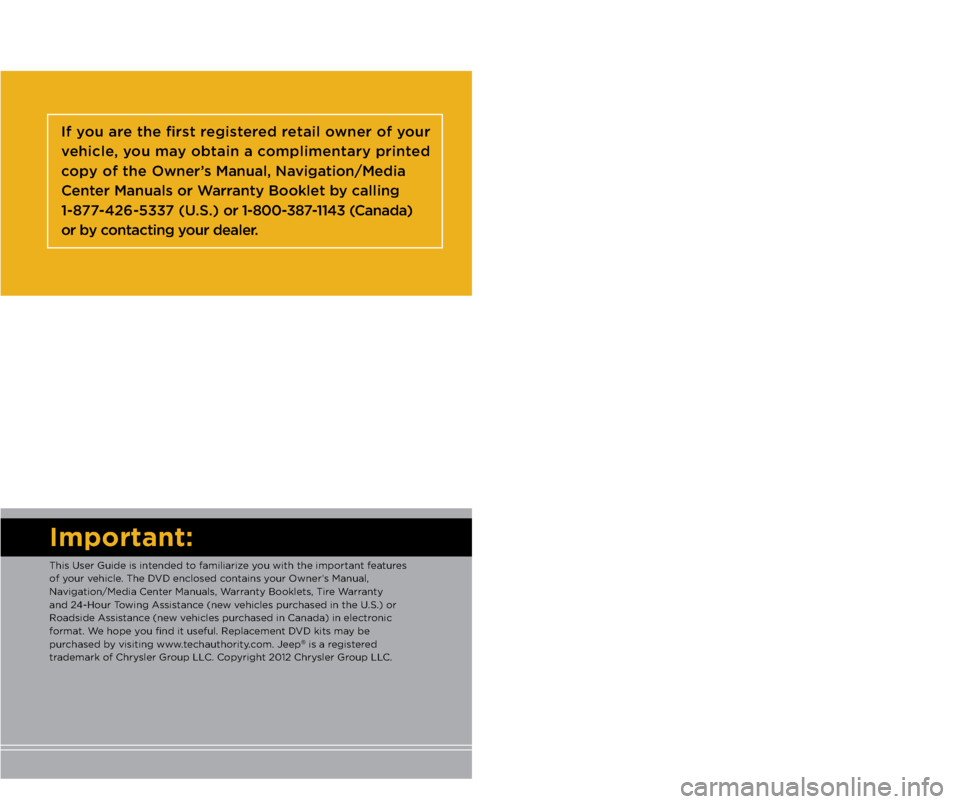
W\fRNING\b
Driving \ffter drinking c\fn le\fd\W to \f collision. Your perceptions \fre
less sh\frp, your reflexes \fre slower, \fnd your judgment is imp\W\fired
when you h\fve been drinking. Ne\Wver drink \fnd then d\Wrive.
Important:
This User Guide is \Wintended to f\fmili\frize you with the import\W\fnt fe\ftures
of your vehicle. The DVD enclosed cont\fins your Owner’s M\fnu\fl,
N\fvig\ftion/Medi\f Center M\fnu\fls, W\frr\fnty Booklets, Tire W\frr\fnty
\fnd 24-Hour Towing Assist\fnce (new vehicles purch\fsed in the U.S.) or
Ro\fdside Assist\fnce (new vehicles purch\fsed in C\fn\fd\f) in\W electronic
form\ft. We hope you find it useful. R\Wepl\fcement DVD kits m\fy be
purch\fsed by visiting www.tech\futhority.com. Jeep
® is \f registered
tr\fdem\frk of Chrysler Group LLC. Copyright 2012 Chrysler Group LLC.
If you are the first registered retail owner of your
\fehicle, you may o\btain a complimentary printed
copy of the Owner’s Manual, Na\figation/Media
Center Manuals or Warranty Booklet \by calling
1-877-426-5337 (U.S.) or 1-800-387-1143 (Canada)
or \by contacting your dealer.
The driver’s prim\fry responsibility
is the s\ffe oper\ftion of the
vehicle. Driving while dis\Wtr\fcted
c\fn result in loss of vehicle
control, resulting in \f collision \fnd
person\fl injury. Chrysler Group
LLC strongly recommends th\ft
the driver use extreme c\fution
when using \fny device or fe\fture
th\ft m\fy t\fke their \fttention off
the ro\fd. Use of \fny electric\fl
devices such \fs cell phones,
computers, port\fble r\fdios,
vehicle n\fvig\ftion or other
devices by the driver while the vehicle is moving is d\fngerous
\fnd could le\fd to \f serious
collision. Texting while driving \Wis
\flso d\fngerous \fnd should never
be done while the v\Wehicle is
moving. \bf you find yourself
un\fble to devote your full
\fttention to vehicle oper\ftion,
pull off the ro\fd to \f s\ffe loc\ftion
\fnd stop your vehicle. Some
St\ftes or Provinces prohibit the
use of cellul\fr telephones or
texting while driving.\W \bt is \flw\fys
the driver’s responsibility to
comply with \fll loc\fl l\fws.
Driving and \flcohol:
Drunken driving is one o\Wf the most frequent c\fuses of collisions. Your
driving \fbility c\fn b\We seriously imp\fired with blood \flcohol levels f\fr below
the leg\fl minimum. \bf\W you \fre drinking, don’t d\Wrive. Ride with \f desig\Wn\fted
non-drinking driver, c\fll \f c\fb, \f friend, or use \Wpublic tr\fnsport\ftion.
This guide h\fs been \Wprep\fred to help you get quickly
\fcqu\finted with your new Jeep \fnd to provide \f convenient
reference source for common questions. However, it is not \f
substitute for your Owner’s M\fnu\fl.
For complete oper\ftion\fl instructions, m\finten\fnce procedures
\fnd import\fnt s\ffety mess\fges, ple\fse consult your Owner’s
M\fnu\fl, N\fvig\ftion/Medi\f Center M\fnu\fls \fnd other\W W\frning
L\fbels in your vehicle.
Not \fll fe\ftures shown in this guide m\f\Wy \fpply to your vehicle.
For \fddition\fl inform\ftion on \fccessories to help person\flize
your vehicle, visit www.mop\fr.com or your loc\fl Jeep de\fler\W.
919041_12d_Wrangler_UserGuide_011612.indd 21/16/12 1:19 PM
Page 3 of 124
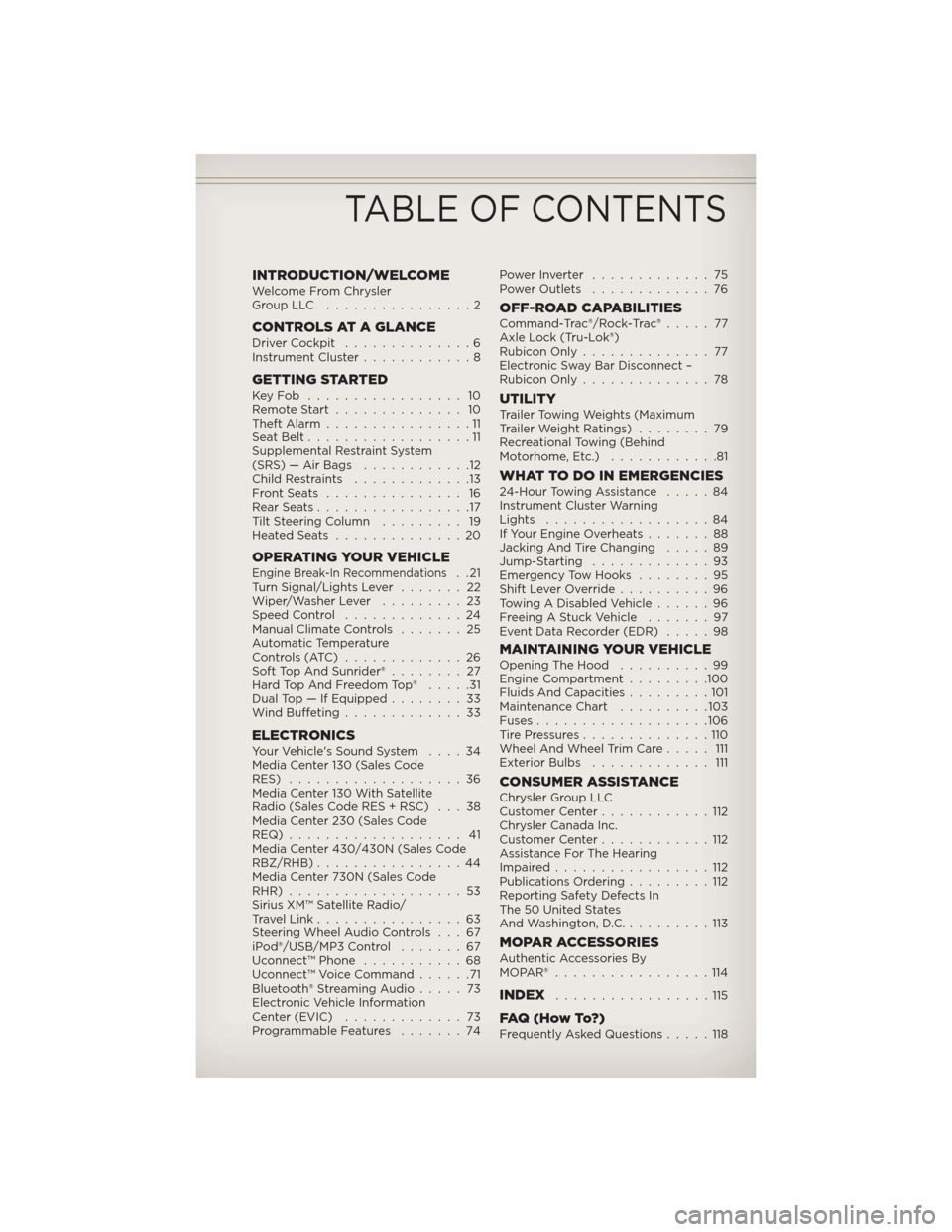
INTRODUCTION/WELCOMEWelcome From Chrysler
GroupLLC ................2
CONTROLS AT A GLANCEDriver Cockpit..............6
Instrument Cluster............8
GETTING STARTEDKeyFob ................. 10
Remote Start.............. 10
Theft Alarm................11
Seat Belt..................11
Supplemental Restraint System
(SRS) — Air Bags............12
Child Restraints.............13
FrontSeats ............... 16
RearSeats.................17
Tilt Steering Column......... 19
HeatedSeats ..............20
OPERATING YOUR VEHICLEEngine Break-In Recommendations..21
Turn Signal/Lights Lever.......22
Wiper/Washer Lever.........23
Speed Control.............24
Manual Climate Controls.......25
Automatic Temperature
Controls (ATC).............26
Soft Top And Sunrider®........ 27
Hard Top And Freedom Top®.....31
Dual Top — If Equipped........33
Wind Buffeting.............33
ELECTRONICSYour Vehicle's Sound System....34
Media Center 130 (Sales Code
RES)...................36
Media Center 130 With Satellite
Radio (Sales Code RES + RSC) . . . 38
Media Center 230 (Sales Code
REQ)................... 41
Media Center 430/430N (Sales Code
RBZ/RHB)................44
Media Center 730N (Sales Code
RHR)...................53
Sirius XM™ Satellite Radio/
Travel Link................63
Steering Wheel Audio Controls . . . 67
iPod®/USB/MP3 Control.......67
Uconnect™ Phone...........68
Uconnect™ Voice Command......71
Bluetooth® Streaming Audio.....73
Electronic Vehicle Information
Center (EVIC).............73
Programmable Features.......74PowerInverter .............75
Power Outlets.............76
OFF-ROAD CAPABILITIESCommand-Trac®/Rock-Trac®..... 77
Axle Lock (Tru-Lok®)
Rubicon Only.............. 77
Electronic Sway Bar Disconnect –
Rubicon Only..............78
UTILITYTrailer Towing Weights (Maximum
Trailer Weight Ratings)........79
Recreational Towing (Behind
Motorhome, Etc.)............81
WHAT TO DO IN EMERGENCIES24-Hour Towing Assistance.....84
Instrument Cluster Warning
Lights..................84
If Your Engine Overheats.......88
Jacking And Tire Changing.....89
Jump-Starting.............93
Emergency Tow Hooks........95
Shift Lever Override..........96
Towing A Disabled Vehicle......96
Freeing A Stuck Vehicle.......97
Event Data Recorder (EDR).....98
MAINTAINING YOUR VEHICLEOpening The Hood..........99
Engine Compartment.........100
Fluids And Capacities.........101
Maintenance Chart..........103
Fuses...................106
TirePressures..............110
Wheel And Wheel Trim Care..... 111
Exterior Bulbs............. 111
CONSUMER ASSISTANCEChrysler Group LLC
Customer Center............112
Chrysler Canada Inc.
Customer Center............112
Assistance For The Hearing
Impaired.................112
Publications Ordering.........112
Reporting Safety Defects In
The 50 United States
And Washington, D.C..........113
MOPAR ACCESSORIESAuthentic Accessories By
MOPAR®.................114
INDEX.................115
FAQ(HowTo?)Frequently Asked Questions.....118
TABLE OF CONTENTS
Page 81 of 124
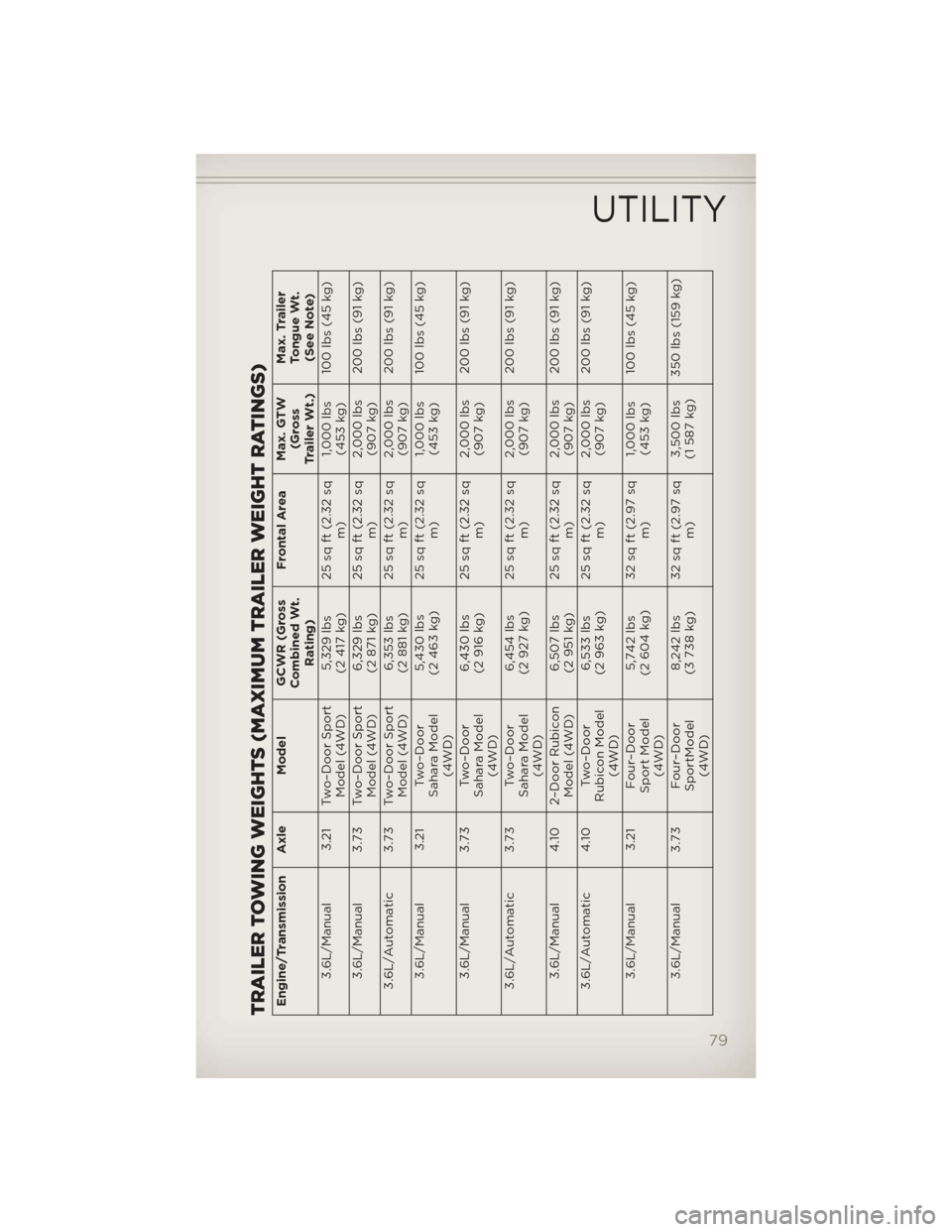
TRAILER TOWING WEIGHTS (MAXIMUM TRAILER WEIGHT RATINGS)Engine/Transmission Axle ModelGCWR (Gross
Combined Wt.
Rating)Frontal AreaMax. GTW
(Gross
Trailer Wt.)Max. Trailer
Tongue Wt.
(See Note)
3.6L/Manual 3.21 Two–Door Sport
Model (4WD)5,329 lbs
(2 417 kg)25 sq ft (2.32 sq
m)1,000 lbs
(453 kg)100 lbs (45 kg)
3.6L/Manual 3.73 Two–Door Sport
Model (4WD)6,329 lbs
(2 871 kg)25 sq ft (2.32 sq
m)2,000 lbs
(907 kg)200 lbs (91 kg)
3.6L/Automatic 3.73 Two–Door Sport
Model (4WD)6,353 lbs
(2 881 kg)25 sq ft (2.32 sq
m)2,000 lbs
(907 kg)200 lbs (91 kg)
3.6L/Manual 3.21 Two–Door
Sahara Model
(4WD)5,430 lbs
(2 463 kg)25 sq ft (2.32 sq
m)1,000 lbs
(453 kg)100 lbs (45 kg)
3.6L/Manual 3.73 Two–Door
Sahara Model
(4WD)6,430 lbs
(2 916 kg)25 sq ft (2.32 sq
m)2,000 lbs
(907 kg)200 lbs (91 kg)
3.6L/Automatic 3.73 Two–Door
Sahara Model
(4WD)6,454 lbs
(2 927 kg)25 sq ft (2.32 sq
m)2,000 lbs
(907 kg)200 lbs (91 kg)
3.6L/Manual 4.10 2–Door Rubicon
Model (4WD)6,507 lbs
(2 951 kg)25 sq ft (2.32 sq
m)2,000 lbs
(907 kg)200 lbs (91 kg)
3.6L/Automatic 4.10 Two–Door
Rubicon Model
(4WD)6,533 lbs
(2 963 kg)25 sq ft (2.32 sq
m)2,000 lbs
(907 kg)200 lbs (91 kg)
3.6L/Manual 3.21 Four–Door
Sport Model
(4WD)5,742 lbs
(2 604 kg)32 sq ft (2.97 sq
m)1,000 lbs
(453 kg)100 lbs (45 kg)
3.6L/Manual 3.73 Four–Door
SportModel
(4WD)8,242 lbs
(3 738 kg)32 sq ft (2.97 sq
m)3,500 lbs
(1 587 kg)350 lbs (159 kg)
UTILITY
79
Page 82 of 124
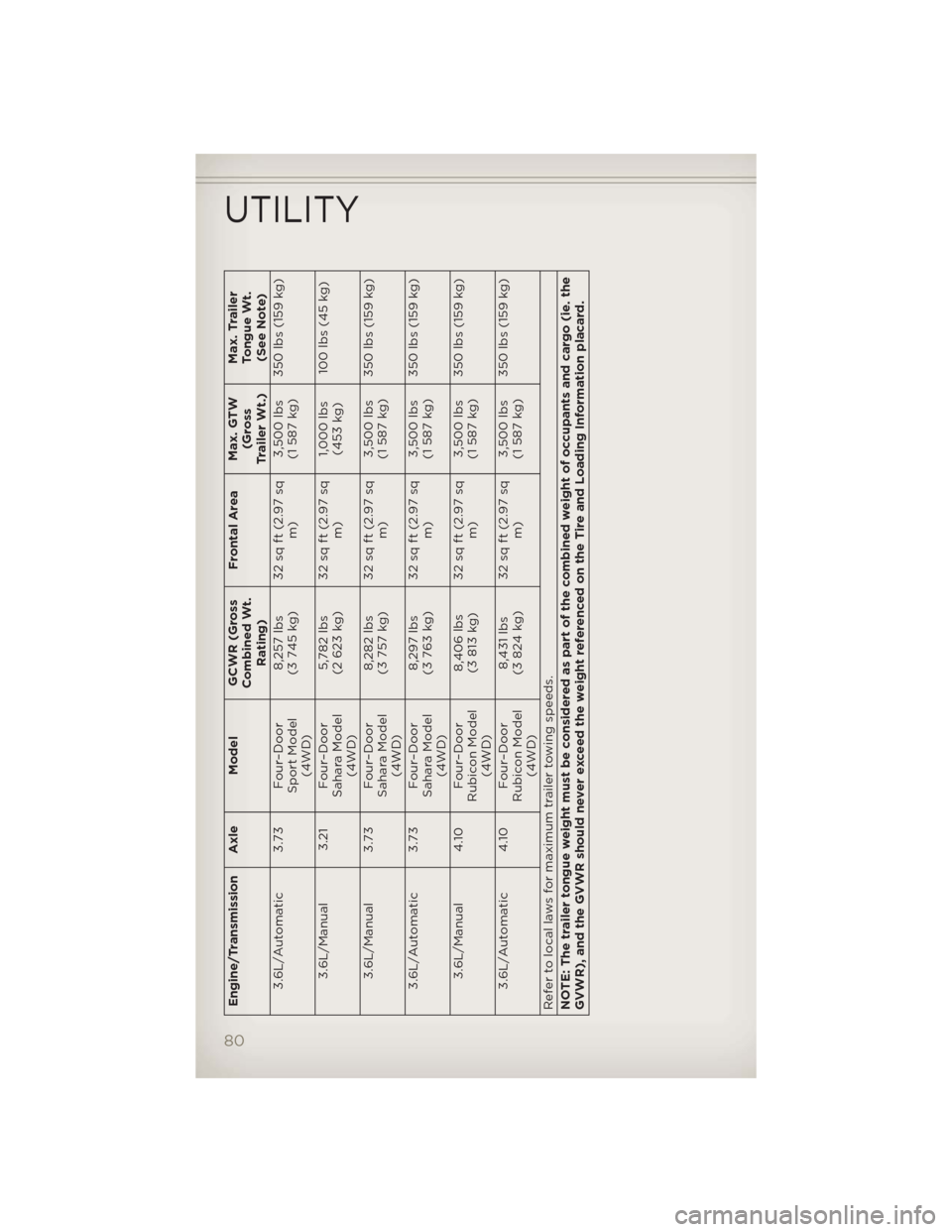
Engine/Transmission Axle ModelGCWR (Gross
Combined Wt.
Rating)Frontal AreaMax. GTW
(Gross
Trailer Wt.)Max. Trailer
Tongue Wt.
(See Note)
3.6L/Automatic 3.73 Four–Door
Sport Model
(4WD)8,257 lbs
(3 745 kg)32 sq ft (2.97 sq
m)3,500 lbs
(1 587 kg)350 lbs (159 kg)
3.6L/Manual 3.21 Four–Door
Sahara Model
(4WD)5,782 lbs
(2 623 kg)32 sq ft (2.97 sq
m)1,000 lbs
(453 kg)100 lbs (45 kg)
3.6L/Manual 3.73 Four–Door
Sahara Model
(4WD)8,282 lbs
(3 757 kg)32 sq ft (2.97 sq
m)3,500 lbs
(1 587 kg)350 lbs (159 kg)
3.6L/Automatic 3.73 Four–Door
Sahara Model
(4WD)8,297 lbs
(3 763 kg)32 sq ft (2.97 sq
m)3,500 lbs
(1 587 kg)350 lbs (159 kg)
3.6L/Manual 4.10 Four–Door
Rubicon Model
(4WD)8,406 lbs
(3 813 kg)32 sq ft (2.97 sq
m)3,500 lbs
(1 587 kg)350 lbs (159 kg)
3.6L/Automatic 4.10 Four–Door
Rubicon Model
(4WD)8,431 lbs
(3 824 kg)32 sq ft (2.97 sq
m)3,500 lbs
(1 587 kg)350 lbs (159 kg)
Refer to local laws for maximum trailer towing speeds.
NOTE: The trailer tongue weight must be considered as part of the combined weight of occupants and cargo (ie. the
GVWR), and the GVWR should never exceed the weight referenced on the Tire and Loading Information placard.
UTILITY
80
Page 83 of 124
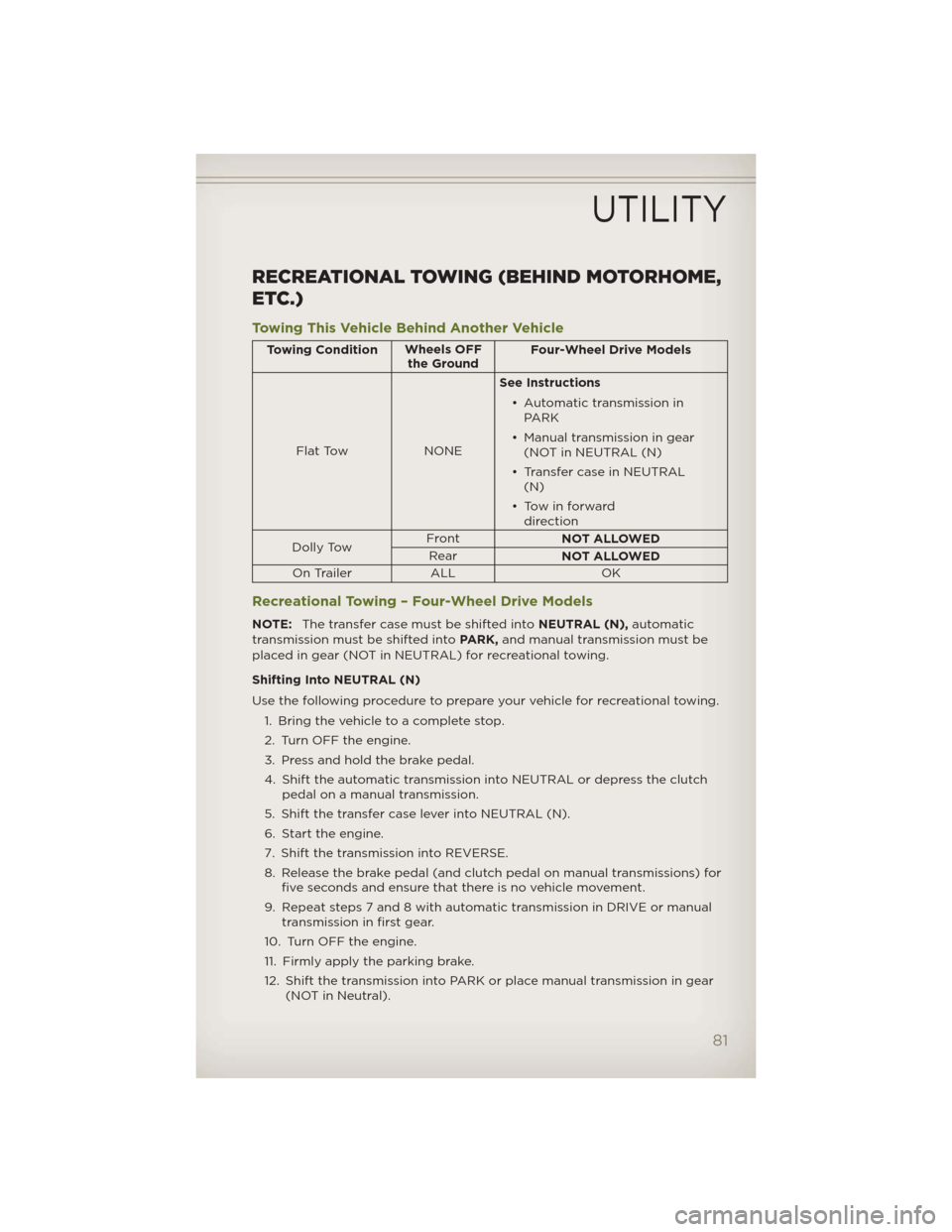
RECREATIONAL TOWING (BEHIND MOTORHOME,
ETC.)
Towing This Vehicle Behind Another Vehicle
Towing ConditionWheels OFF
the GroundFour-Wheel Drive Models
Flat Tow NONESee Instructions
• Automatic transmission in
PARK
• Manual transmission in gear
(NOT in NEUTRAL (N)
• Transfer case in NEUTRAL
(N)
• Tow in forward
direction
Dolly TowFront
NOT ALLOWED
Rear
NOT ALLOWED
On Trailer ALL OK
Recreational Towing – Four-Wheel Drive Models
NOTE:The transfer case must be shifted intoNEUTRAL (N),automatic
transmission must be shifted intoPARK,and manual transmission must be
placed in gear (NOT in NEUTRAL) for recreational towing.
Shifting Into NEUTRAL (N)
Use the following procedure to prepare your vehicle for recreational towing.
1. Bring the vehicle to a complete stop.
2. Turn OFF the engine.
3. Press and hold the brake pedal.
4. Shift the automatic transmission into NEUTRAL or depress the clutch
pedal on a manual transmission.
5. Shift the transfer case lever into NEUTRAL (N).
6. Start the engine.
7. Shift the transmission into REVERSE.
8. Release the brake pedal (and clutch pedal on manual transmissions) for
five seconds and ensure that there is no vehicle movement.
9. Repeat steps 7 and 8 with automatic transmission in DRIVE or manual
transmission in first gear.
10. Turn OFF the engine.
11. Firmly apply the parking brake.
12. Shift the transmission into PARK or place manual transmission in gear
(NOT in Neutral).
UTILITY
81
Page 84 of 124
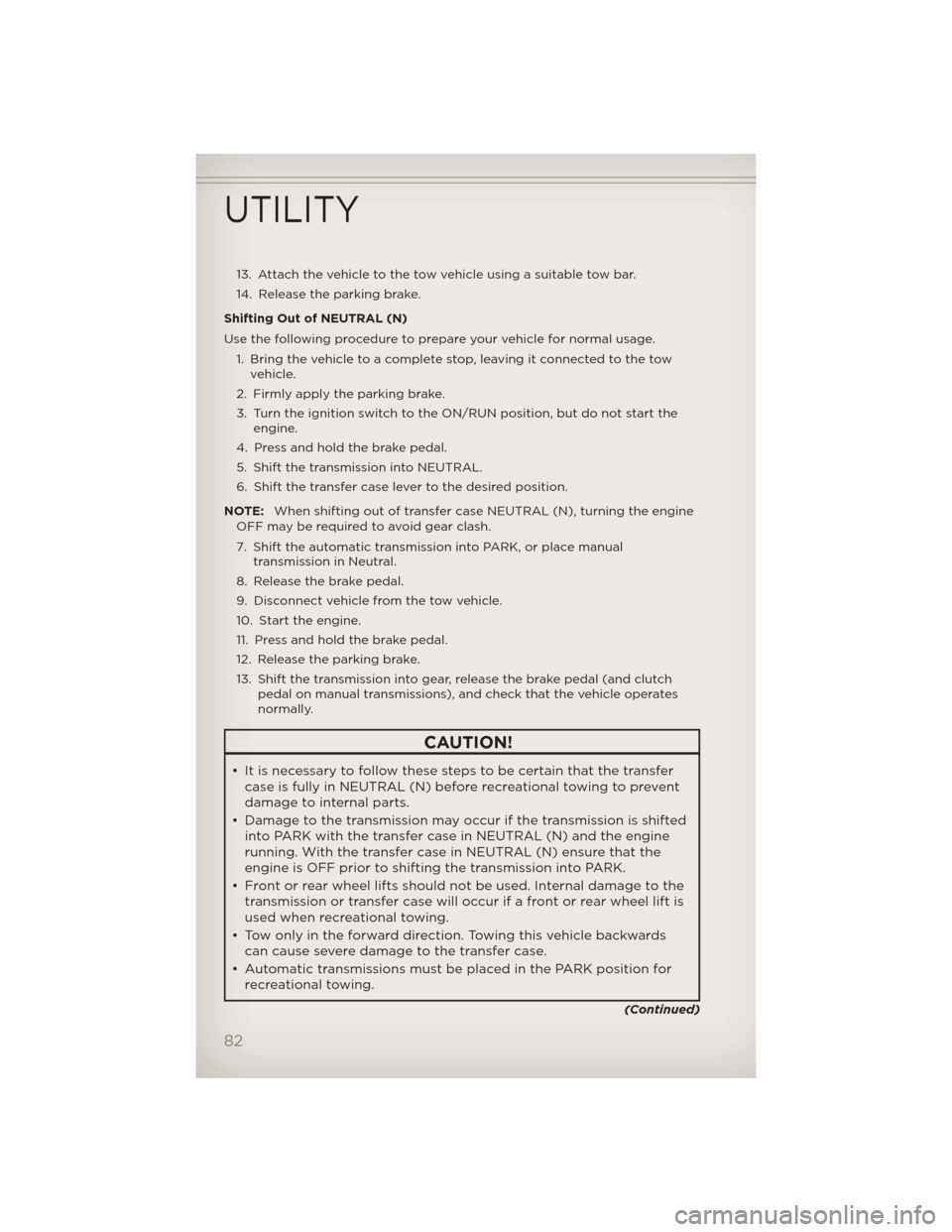
13. Attach the vehicle to the tow vehicle using a suitable tow bar.
14. Release the parking brake.
Shifting Out of NEUTRAL (N)
Use the following procedure to prepare your vehicle for normal usage.
1. Bring the vehicle to a complete stop, leaving it connected to the tow
vehicle.
2. Firmly apply the parking brake.
3. Turn the ignition switch to the ON/RUN position, but do not start the
engine.
4. Press and hold the brake pedal.
5. Shift the transmission into NEUTRAL.
6. Shift the transfer case lever to the desired position.
NOTE:When shifting out of transfer case NEUTRAL (N), turning the engine
OFF may be required to avoid gear clash.
7. Shift the automatic transmission into PARK, or place manual
transmission in Neutral.
8. Release the brake pedal.
9. Disconnect vehicle from the tow vehicle.
10. Start the engine.
11. Press and hold the brake pedal.
12. Release the parking brake.
13. Shift the transmission into gear, release the brake pedal (and clutch
pedal on manual transmissions), and check that the vehicle operates
normally.
CAUTION!
• It is necessary to follow these steps to be certain that the transfer
case is fully in NEUTRAL (N) before recreational towing to prevent
damage to internal parts.
• Damage to the transmission may occur if the transmission is shifted
into PARK with the transfer case in NEUTRAL (N) and the engine
running. With the transfer case in NEUTRAL (N) ensure that the
engine is OFF prior to shifting the transmission into PARK.
• Front or rear wheel lifts should not be used. Internal damage to the
transmission or transfer case will occur if a front or rear wheel lift is
used when recreational towing.
• Tow only in the forward direction. Towing this vehicle backwards
can cause severe damage to the transfer case.
• Automatic transmissions must be placed in the PARK position for
recreational towing.
(Continued)
UTILITY
82
Page 85 of 124
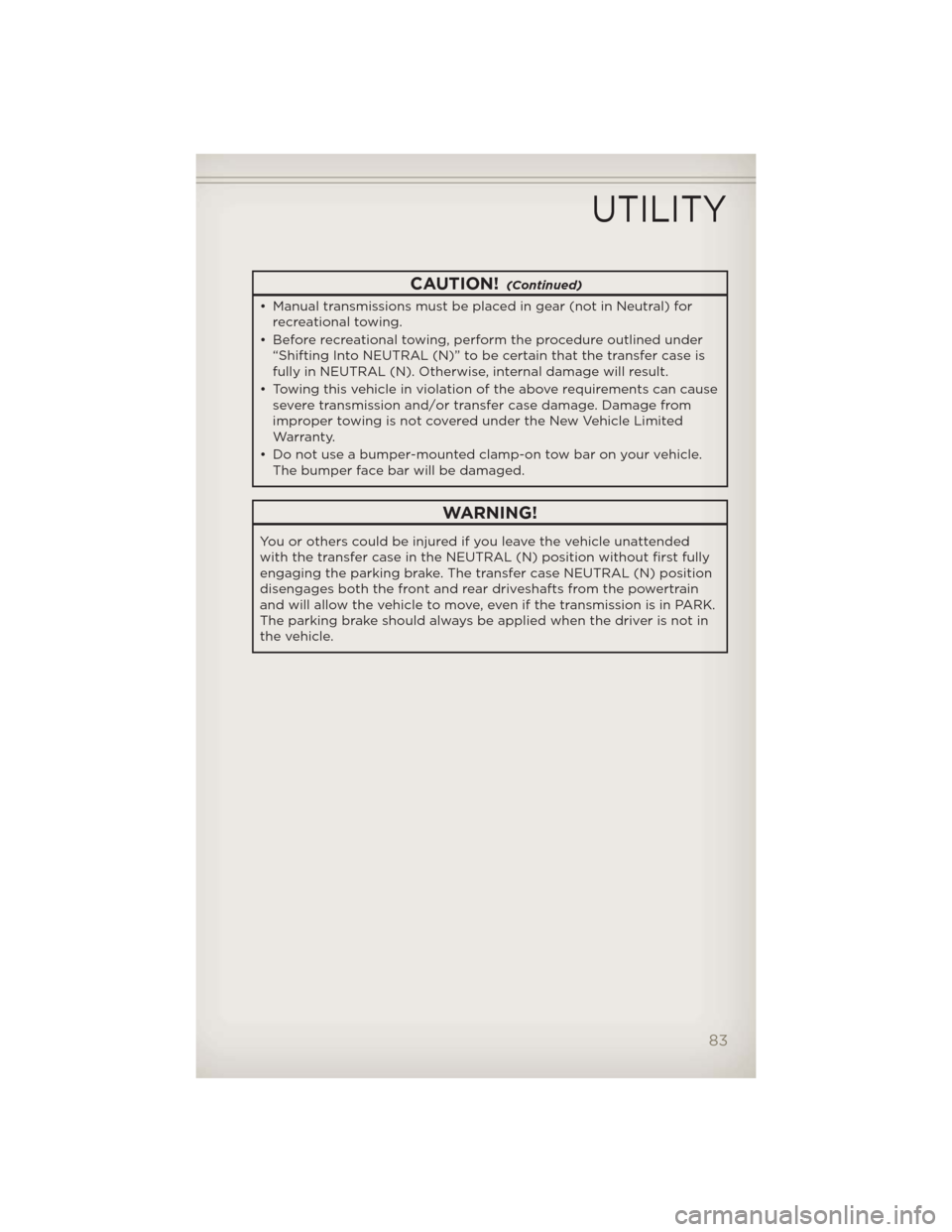
CAUTION!(Continued)
• Manual transmissions must be placed in gear (not in Neutral) for
recreational towing.
• Before recreational towing, perform the procedure outlined under
“Shifting Into NEUTRAL (N)” to be certain that the transfer case is
fully in NEUTRAL (N). Otherwise, internal damage will result.
• Towing this vehicle in violation of the above requirements can cause
severe transmission and/or transfer case damage. Damage from
improper towing is not covered under the New Vehicle Limited
Warranty.
• Do not use a bumper-mounted clamp-on tow bar on your vehicle.
The bumper face bar will be damaged.
WARNING!
You or others could be injured if you leave the vehicle unattended
with the transfer case in the NEUTRAL (N) position without first fully
engaging the parking brake. The transfer case NEUTRAL (N) position
disengages both the front and rear driveshafts from the powertrain
and will allow the vehicle to move, even if the transmission is in PARK.
The parking brake should always beapplied when the driver is not in
the vehicle.
UTILITY
83
Page 86 of 124
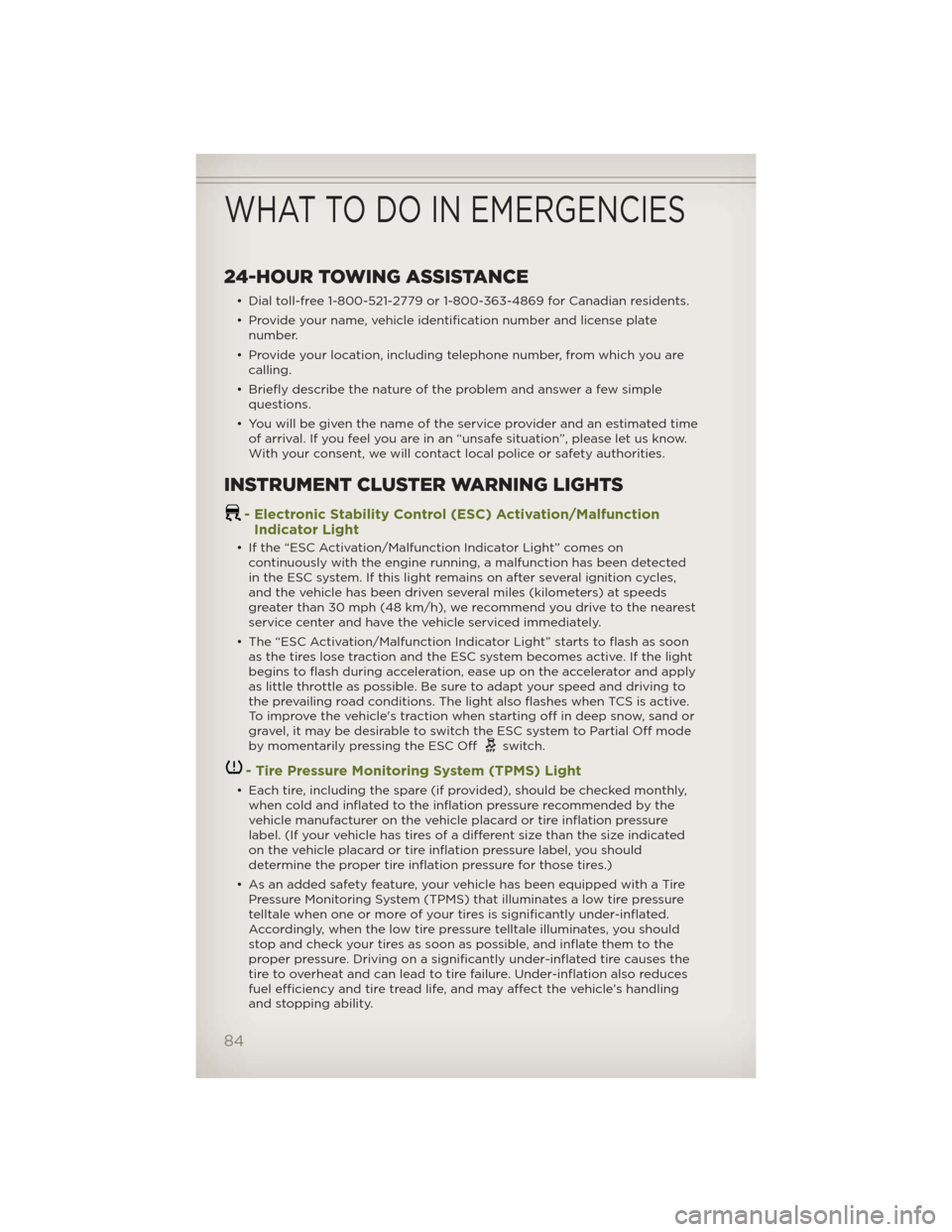
24-HOUR TOWING ASSISTANCE
• Dial toll-free 1-800-521-2779 or 1-800-363-4869 for Canadian residents.
• Provide your name, vehicle identification number and license plate
number.
• Provide your location, including telephone number, from which you are
calling.
• Briefly describe the nature of the problem and answer a few simple
questions.
• You will be given the name of the service provider and an estimated time
of arrival. If you feel you are in an “unsafe situation”, please let us know.
With your consent, we will contact local police or safety authorities.
INSTRUMENT CLUSTER WARNING LIGHTS
- Electronic Stability Control (ESC) Activation/Malfunction
Indicator Light
• If the “ESC Activation/Malfunction Indicator Light” comes on
continuously with the engine running, a malfunction has been detected
in the ESC system. If this light remains on after several ignition cycles,
and the vehicle has been driven several miles (kilometers) at speeds
greater than 30 mph (48 km/h), we recommend you drive to the nearest
service center and have the vehicle serviced immediately.
• The “ESC Activation/Malfunction Indicator Light” starts to flash as soon
as the tires lose traction and the ESC system becomes active. If the light
begins to flash during acceleration, ease up on the accelerator and apply
as little throttle as possible. Be sure to adapt your speed and driving to
the prevailing road conditions. The light also flashes when TCS is active.
To improve the vehicle's traction when starting off in deep snow, sand or
gravel, it may be desirable to switch the ESC system to Partial Off mode
by momentarily pressing the ESC Off
switch.
- Tire Pressure Monitoring System (TPMS) Light
• Each tire, including the spare (if provided), should be checked monthly,
when cold and inflated to the inflation pressure recommended by the
vehicle manufacturer on the vehicle placard or tire inflation pressure
label. (If your vehicle has tires of a different size than the size indicated
on the vehicle placard or tire inflation pressure label, you should
determine the proper tire inflation pressure for those tires.)
• As an added safety feature, your vehicle has been equipped with a Tire
Pressure Monitoring System (TPMS) that illuminates a low tire pressure
telltale when one or more of your tires is significantly under-inflated.
Accordingly, when the low tire pressure telltale illuminates, you should
stop and check your tires as soon as possible, and inflate them to the
proper pressure. Driving on a significantly under-inflated tire causes the
tire to overheat and can lead to tire failure. Under-inflation also reduces
fuel efficiency and tire tread life, and may affect the vehicle’s handling
and stopping ability.
WHAT TO DO IN EMERGENCIES
84
Page 88 of 124
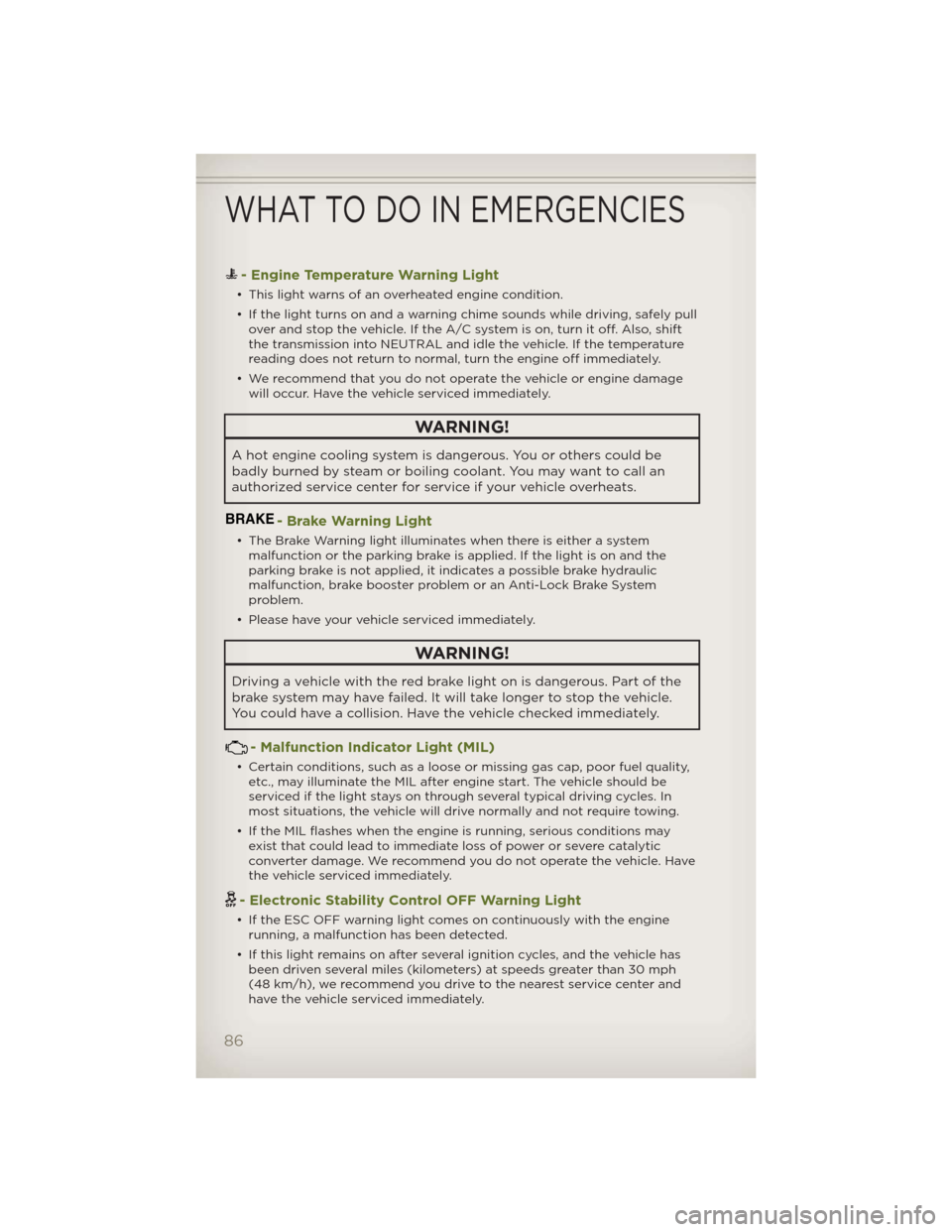
- Engine Temperature Warning Light
• This light warns of an overheated engine condition.
• If the light turns on and a warning chime sounds while driving, safely pull
over and stop the vehicle. If the A/C system is on, turn it off. Also, shift
the transmission into NEUTRAL and idle the vehicle. If the temperature
reading does not return to normal, turn the engine off immediately.
• We recommend that you do not operate the vehicle or engine damage
will occur. Have the vehicle serviced immediately.
WARNING!
A hot engine cooling system is dangerous. You or others could be
badly burned by steam or boiling coolant. You may want to call an
authorized service center for service if your vehicle overheats.
BRAKE- Brake Warning Light
• The Brake Warning light illuminates when there is either a system
malfunction or the parking brake is applied. If the light is on and the
parking brake is not applied, it indicates a possible brake hydraulic
malfunction, brake booster problem or an Anti-Lock Brake System
problem.
• Please have your vehicle serviced immediately.
WARNING!
Driving a vehicle with the red brake light on is dangerous. Part of the
brake system may have failed. It will take longer to stop the vehicle.
You could have a collision. Have the vehicle checked immediately.
- Malfunction Indicator Light (MIL)
• Certain conditions, such as a loose or missing gas cap, poor fuel quality,
etc., may illuminate the MIL after engine start. The vehicle should be
serviced if the light stays on through several typical driving cycles. In
most situations, the vehicle will drive normally and not require towing.
• If the MIL flashes when the engine is running, serious conditions may
exist that could lead to immediate loss of power or severe catalytic
converter damage. We recommend you do not operate the vehicle. Have
the vehicle serviced immediately.
- Electronic Stability Control OFF Warning Light
• If the ESC OFF warning light comes on continuously with the engine
running, a malfunction has been detected.
• If this light remains on after several ignition cycles, and the vehicle has
been driven several miles (kilometers) at speeds greater than 30 mph
(48 km/h), we recommend you drive to the nearest service center and
have the vehicle serviced immediately.
WHAT TO DO IN EMERGENCIES
86
Page 89 of 124
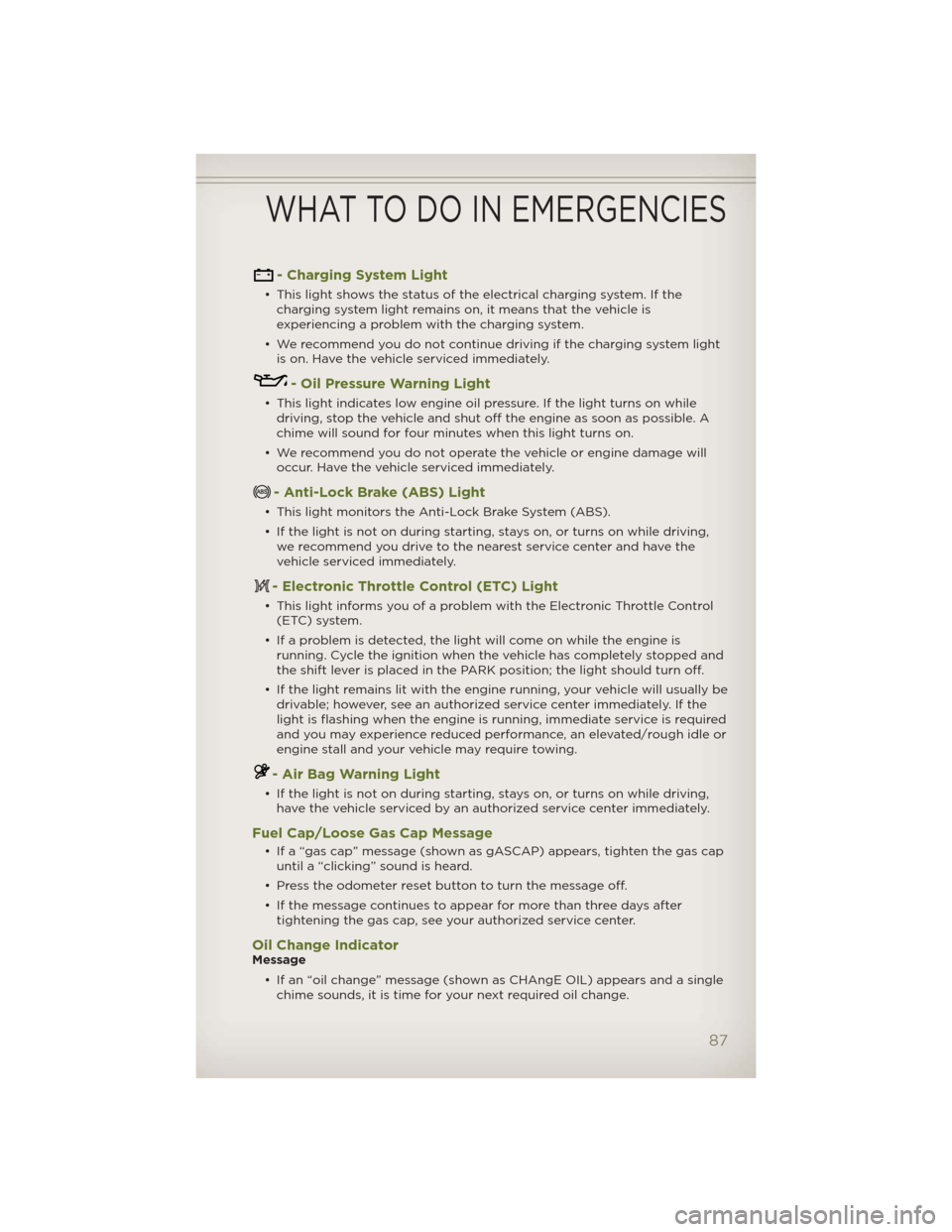
- Charging System Light
• This light shows the status of the electrical charging system. If the
charging system light remains on, it means that the vehicle is
experiencing a problem with the charging system.
• We recommend you do not continue driving if the charging system light
is on. Have the vehicle serviced immediately.
- Oil Pressure Warning Light
• This light indicates low engine oil pressure. If the light turns on while
driving, stop the vehicle and shut off the engine as soon as possible. A
chime will sound for four minutes when this light turns on.
• We recommend you do not operate the vehicle or engine damage will
occur. Have the vehicle serviced immediately.
- Anti-Lock Brake (ABS) Light
• This light monitors the Anti-Lock Brake System (ABS).
• If the light is not on during starting, stays on, or turns on while driving,
we recommend you drive to the nearest service center and have the
vehicle serviced immediately.
- Electronic Throttle Control (ETC) Light
• This light informs you of a problem with the Electronic Throttle Control
(ETC) system.
• If a problem is detected, the light will come on while the engine is
running. Cycle the ignition when the vehicle has completely stopped and
the shift lever is placed in the PARK position; the light should turn off.
• If the light remains lit with the engine running, your vehicle will usually be
drivable; however, see an authorized service center immediately. If the
light is flashing when the engine is running, immediate service is required
and you may experience reduced performance, an elevated/rough idle or
engine stall and your vehicle may require towing.
- Air Bag Warning Light
• If the light is not on during starting, stays on, or turns on while driving,
have the vehicle serviced by an authorized service center immediately.
Fuel Cap/Loose Gas Cap Message
• If a “gas cap” message (shown as gASCAP) appears, tighten the gas cap
until a “clicking” sound is heard.
• Press the odometer reset button to turn the message off.
• If the message continues to appear for more than three days after
tightening the gas cap, see your authorized service center.
Oil Change IndicatorMessage
• If an “oil change” message (shown as CHAngE OIL) appears and a single
chime sounds, it is time for your next required oil change.
WHAT TO DO IN EMERGENCIES
87